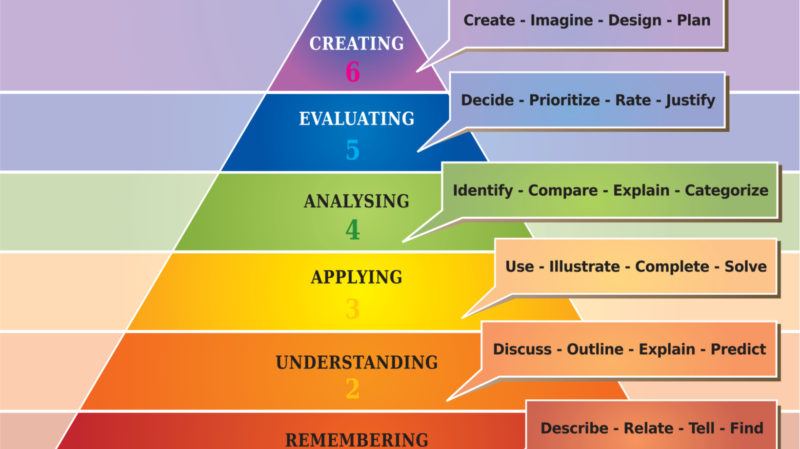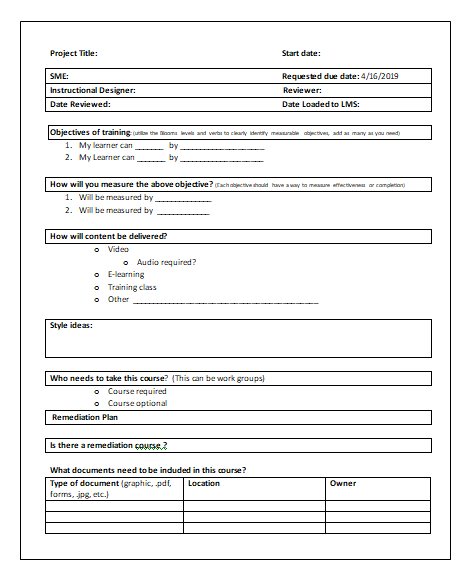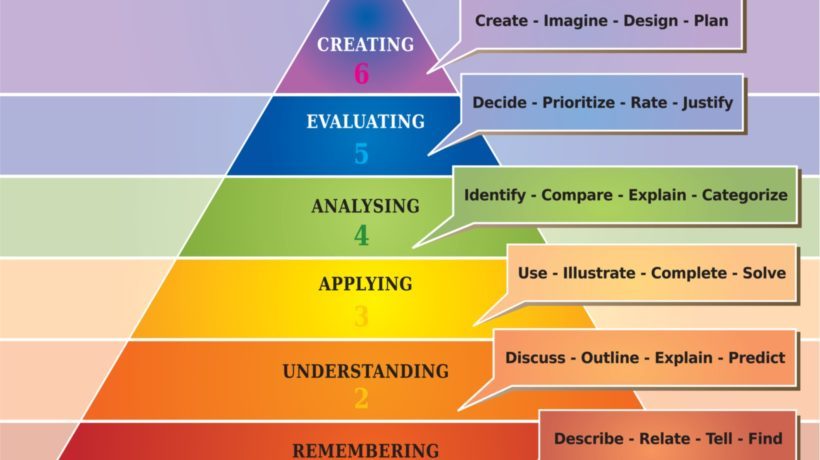Using Bloom’s Taxonomy For Business
Bloom’s Taxonomy is something you typically hear about in regards to a K-12 classroom, not in regards to a business environment. I would argue that Bloom’s Taxonomy is as important for business as it is for a classroom if not more important. Bloom’s Taxonomy has levels of learning that are as follows:

artellia/Shutterstock.com
As you move up the levels, the learning that occurs is more complex and needs more support either in a training session, via an eLearning course or in subsequent follow-up sessions or job aids. The complexity of the thinking and the connections that need to occur need more time, practice and support.
Here are some examples of the kind of learning that could occur on each level. There are thousands of examples that could be used.
- Create
It could be how to use a new CAD system to design a car part. - Evaluate
It could be to weigh the new features of a new tool or system. - Analyze
It could be to assess the features of several new products and contrast the benefits to your organization. - Apply
It could be to utilize a new tool to make a sale to a customer. - Understand
It could be to understand the new contract language and how it applies to your job. - Remember
It could be that the information needed is in a job aid and where to reference that job aid.
Creating A Measurable Objective
While an Instructional Designer is meeting with a Subject Matter Expert, they need to identify the objectives of the training. Bloom’s Taxonomy levels help to identify and create objectives and codify what you are asking the learner to be able to do when the session is complete. I find that the verb chart helps me to brainstorm the most effective objectives quickly and succinctly.
When I was a classroom teacher, each day, I was required to write the objective of each class on my board. It started with I can _________________by _________________. For example, I can understand the parts of a cell by creating a model of it. Or I can differentiate the carbon cycle from the nitrogen cycle by comparing and contrasting their inputs and outputs.
When applied to a business situation, we can create the same kind of objectives. I can utilize the loan beam system by discovering how to input loan documents and completing a test loan.
Or
I can apply the correct scheduling rule in the new system by accessing the flowchart for the appropriate scenario.
After you have identified your objectives, think about how you will measure them.
For our first objective, I can utilize the loan beam system by discovering how to input loan documents and completing a test loan.
You can measure your learner’s effectiveness by two outcomes for this goal. First, they can use the new system as evidenced by the inputting of a test loan, but more importantly, they can input a loan into the production system. This is easy to see evidence of success, as either they did it or they did not, and need additional support. If they need additional support, identify where they needed assistance. Consider changing how the training is delivered so more are successful for future learners.
Our second objective is that I can apply the correct scheduling rule in the new system by accessing the flowchart for the appropriate scenario.
This can be measured by looking at who was scheduled and if the correct rule was utilized. If it was not used correctly consider how to improve the use, ask: is it additional training, emails with situational examples, or coaching by the team leader?
There are as many ways to remediate an objective as there are ways to create one. Spending time with your SME clearly identifying objectives helps to focus the contents of the course and create measurable learning. As you work with the SME to storyboard your course, keep the objectives in mind as you go through each step.
This is an example of a storyboard layout for an eLearning course.

Here are the storyboard headers for a workshop or classroom training course.

Reference each step in the storyboard to the objective you are trying to accomplish with this learning.
When starting a new project consider using a form to ensure you have all the information you need. Here is a sample:

To create effective learning that respects the time away from the job requires attention to detail before the training is developed. Focus on key objectives of the training and the level of learning that is required for the new skill to be utilized on the job. As you move up the levels of Bloom’s Taxonomy, the learning will take more time to become second nature to your learners, and you may also need additional ongoing support. By identifying the level of learning early, you will be able to focus on the tasks that can support the new skill and measure their outcome.










